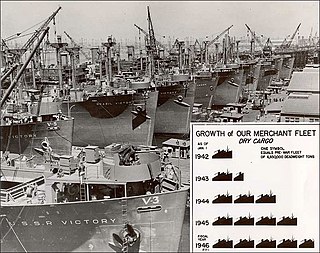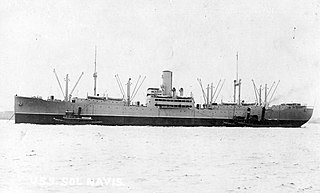
The War Shipping Administration (WSA) was a World War II emergency war agency of the US government, tasked to purchase and operate the civilian shipping tonnage the United States needed for fighting the war. Both shipbuilding under the Maritime Commission and ship allocation under the WSA to Army, Navy or civilian needs were closely coordinated though Vice Admiral Emory S. Land who continued as head of the Maritime Commission while also heading the WSA.
SS Russell A. Alger,, was a Liberty ship named after Russell A. Alger, a Michigan Senator, Governor and U.S. Secretary of War.
SS Daniel Webster was a Liberty ship built in the United States during World War II.

MS Klipfontein was a Dutch ocean liner launched in March 1939 and delivered 29 July intended for South African service. Declaration of war in Europe, including Britain and South Africa declaring war on Germany, resulted in the ship being transferred to service between the Dutch East Indies and the west coast of North America. After the German invasion of the Netherlands in May 1940, with the Dutch government in exile in London, the ship supported the Allied war effort. After entry of the United States into the war the ship was operated by Dutch agents of the U.S. War Shipping Administration (WSA) from February 1942 to February 1946 as a troopship from the U.S. West Coast to Pacific war zones.
USS Nausett (IX–190) was a tanker serving as an auxiliary ship in the United States Navy during World War II. Built as W. M. Irish the ship was a commercial tanker until taken by the War Shipping Administration (WSA) during World War II. WSA first allocated the ship to the Army and then as lend lease to the Soviet Union where the ship was renamed Moskva. On return the ship was renamed Nausett and allocated to the Navy which first accepted the vessel and then found it too expensive to make suitable. The ship was returned to WSA, placed in reserve and sold for scrap the next year.

USS Mizar (AF-12) was the United Fruit Company fruit, mail and passenger liner Quirigua that served as a United States Navy Mizar-class stores ship in World War II.

USNS Bald Eagle (T-AF-50) was a Maritime Commission type C2-S-B1 cargo ship delivered to the War Shipping Administration (WSA) in May 1943. The ship was operated by WSA agent shipping companies until July 1948 when laid up in the James River Reserve Fleet briefly before beginning operation for the U.S. Army in October. When the Navy's Military Sea Transportation Service (MSTS) took over all military ocean shipping in 1950 the ship was transferred to operate as one of six refrigerated cargo ships in the MSTS fleet until July 1970 as USNS Bald Eagle. The ship was permanently transferred to Maritime Commission custody in September 1971 and sold for scrap in 1973.
The USS Araner (IX-226) was laid down as the liberty ship Juan de Fuca under a Maritime Commission contract on 15 November 1942 at Vancouver, Washington, by the Oregon Shipbuilding Company and launched on 27 December 1942. The ship was delivered to the War Shipping Administration (WSA) on 11 January 1943 and immediately placed under a standard WSA operating agreement with Weyerhauser Steamship Company.

USS George F. Elliott (AP-105) was a cargo liner built for the Mississippi Shipping Company as SS Delbrasil for operation between New Orleans and the east coast of South America in 1939 by its operator, Delta Line. The ship entered that service and operated until taken over by the War Shipping Administration (WSA) on 28 April 1942 for operation by Delta Line acting as WSA's agent. On 25 August 1943 WSA allocated the ship to the Navy for conversion to a troop transport commissioned and operated by the Navy for the duration of the war. Ownership of the ship was transferred from Mississippi Shipping to WSA on 4 February 1944 while under Navy operation and was retained until sale to American South African Lines on 22 December 1948. The ship was renamed African Endeavor until returned as a trade in to the Maritime Commission on 22 September 1960 for layup in the James River reserve fleet and later sold to Boston Metals for scrapping.

The Type C4-class ship were the largest cargo ships built by the United States Maritime Commission (MARCOM) during World War II. The design was originally developed for the American-Hawaiian Lines in 1941, but in late 1941 the plans were taken over by the MARCOM.
USS Chestnut Hill (ID-2526) was a commercial tanker that served briefly with the United States Navy during World War I. The ship was ordered as Desdemona for British service but requisitioned by the United States Shipping Board (USSB) for U.S. service and renamed Chestnut Hill before completion. After commissioning and assignment to the Naval Overseas Transportation Service (NOTS) the ship served as an escort and fueling ship for fleets of U.S. submarine chasers crossing the Atlantic.

SS Sea Marlin was a C3-S-A2 cargo ship operated for the War Shipping Administration (WSA) by Grace Lines during World War II. WSA allocated Sea Marlin to United States Army requirements. Sea Marlin was crewed by United States Merchant Marines, with a contingent of the US Naval Armed Guards for the guns and had a complement of the US Army Transportation Corps aboard for troop administration.

USAHS Acadia was the first United States Army Hospital Ship in World War II. Built in 1932 by Newport News Shipbuilding as a civilian passenger/cargo ocean liner for the Eastern Steamship Lines, the ship was in US coastal and Caribbean service prior to its acquisition by the US Maritime Administration in 1941.

MS Sea Witch was a United States Maritime Commission type C2 cargo ship, the first of four pre-war hulls, built by Tampa Shipbuilding & Engineering Company, Tampa, Florida and delivered in July 1940. The ship was of the basic C2 design, rather than the more numerous C2-S, C2-S-A1, C2-S-B1 types and four C2-T hulls delivered December 1941 through March 1942. Sea Witch was one of the relatively few C2 types built with diesel engines.

Registan, built 1910, was the first name for a ship serving fifty years under the later names Guantanamo, USS Guantanamo (ID-1637), Comerio, Vittorin, Grey Lag and finally Hai Lung until scrapping in 1960. The ship transported gunpowder and munitions during World War I as USS Guantanamo and as a cargo ship during World War II for the War Shipping Administration (WSA). After 12 October 1943 the ship was assigned to the Southwest Pacific Area command's permanent local fleet as the United States Army transport Grey Lag with that fleet's number X-101. In April 1945 she was one of the transports towing large barges from Australia and New Guinea to the Philippines after that concept to mitigate shipping shortages had been proven feasible. In 1946 the ship was sold to the Republic of China and renamed Hai Lung.
SS Haiti was a passenger and freight ship built for the Colombian Mail Steamship Company built at Newport News Shipbuilding, Newport News, Virginia and delivered 15 December 1932. The ship was renamed briefly Puerto Rico in 1938 and Monterey in 1939 to operate for the New York and Cuba Mail Steamship Company until requisitioned with transfer of title to the War Shipping Administration (WSA) on 25 September 1942. The ship was then allocated to the U.S. Army for operation under a bareboat agreement as USAT Monterey. In 1943 the ship was assigned to the command at Trinidad to supply bases in Brazil and Ascension Island. After layup in the reserve fleet the ship was sold to Turkey.
Aloha State built by Western Pipe and Steel Company, San Francisco, as Sea Snipe for the United States Maritime Commission as a standard Type C3-S-A2 transport ship. The ship was one of the first of the standard vessels modified into a troop transport. Sea Snipe was completed 29 May 1943 and delivered to the War Shipping Administration (WSA) upon completion. American President Lines operated the ship throughout the war under a WSA agreement. The ship, after brief charter to the British Ministry of War Transport in 1946 and lay up in 1947 served as a civilian transport ship for 24 years, first as Edward Luckenbach for Luckenbach Steamship Company then Aloha State for States Marine Lines. The ship was scrapped in August 1971.

USAT Cuba was the passenger ship Cuba of the Peninsular & Occidental Steamship Company built by William Cramp & Sons Shipbuilding Company, Philadelphia in 1920 and placed into operation in 1921 for scheduled passenger and freight service between Tampa, Key West and Havana.

The SS Harry Luckenbach, built as a cargo ship ordered by the Luckenbach Steamship Company and built at Sun Shipbuilding and Drydock Co. in Chester, Pennsylvania in 1919. The as yet unnamed ship was requisitioned by the United States Shipping Board (USSB) before completion and converted to a troop transport. The USSB allocated the ship, which had been fitted out with temporary troop accommodation in its cargo spaces, to the Navy which commissioned the ship on 7 July 1919 as USS Sol Navis with the Identification number 4031A. The ship was decommissioned October 1919 after two trips to France.

SS Lake Elsmere was an Emergency Fleet Corporation (EFC) Design 1074 cargo ship built for the United States Shipping Board (USSB) during the massive shipbuilding effort of World War I.













